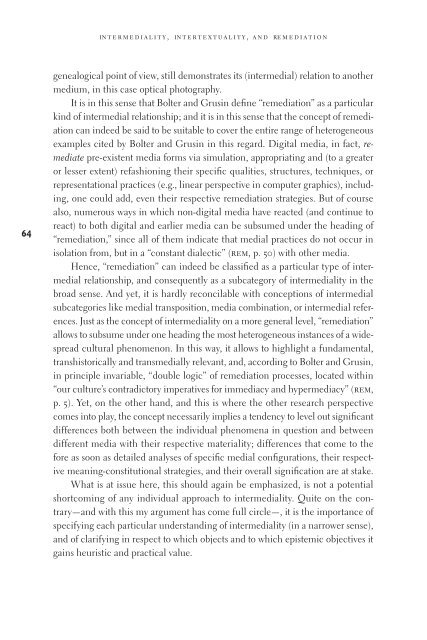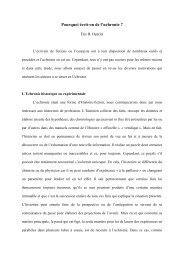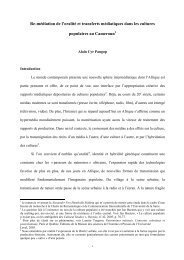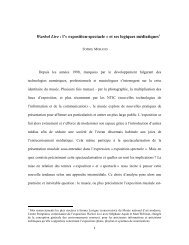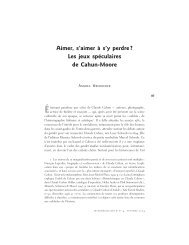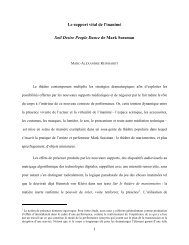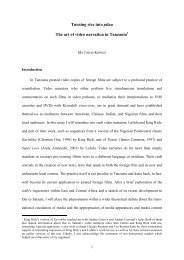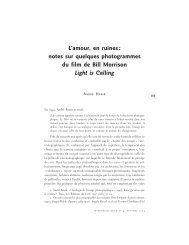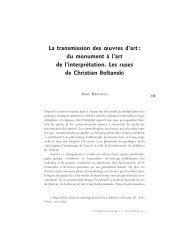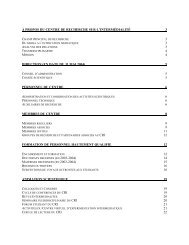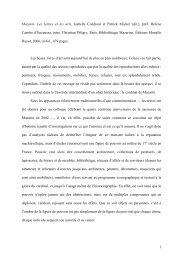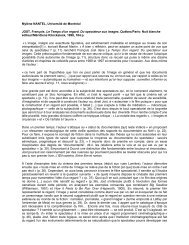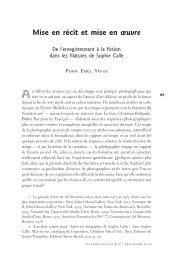Intermediality - Centre de recherche sur l'intermédialité (CRI ...
Intermediality - Centre de recherche sur l'intermédialité (CRI ...
Intermediality - Centre de recherche sur l'intermédialité (CRI ...
Create successful ePaper yourself
Turn your PDF publications into a flip-book with our unique Google optimized e-Paper software.
64<br />
intermediality, intertextuality, and remediation<br />
genealogical point of view, still <strong>de</strong>monstrates its (intermedial) relation to another<br />
medium, in this case optical photography.<br />
It is in this sense that Bolter and Grusin <strong>de</strong>fi ne “remediation” as a particular<br />
kind of intermedial relationship; and it is in this sense that the concept of remediation<br />
can in<strong>de</strong>ed be said to be suitable to cover the entire range of heterogeneous<br />
examples cited by Bolter and Grusin in this regard. Digital media, in fact, remediate<br />
pre-existent media forms via simulation, appropriating and (to a greater<br />
or lesser extent) refashioning their specifi c qualities, structures, techniques, or<br />
representational practices (e.g., linear perspective in computer graphics), including,<br />
one could add, even their respective remediation strategies. But of course<br />
also, numerous ways in which non-digital media have reacted (and continue to<br />
react) to both digital and earlier media can be subsumed un<strong>de</strong>r the heading of<br />
“remediation,” since all of them indicate that medial practices do not occur in<br />
isolation from, but in a “constant dialectic” (rem, p. 50) with other media.<br />
Hence, “remediation” can in<strong>de</strong>ed be classifi ed as a particular type of intermedial<br />
relationship, and consequently as a subcategory of intermediality in the<br />
broad sense. And yet, it is hardly reconcilable with conceptions of intermedial<br />
subcategories like medial transposition, media combination, or intermedial references.<br />
Just as the concept of intermediality on a more general level, “remediation”<br />
allows to subsume un<strong>de</strong>r one heading the most heterogeneous instances of a wi<strong>de</strong>spread<br />
cultural phenomenon. In this way, it allows to highlight a fundamental,<br />
transhistorically and transmedially relevant, and, according to Bolter and Grusin,<br />
in principle invariable, “double logic” of remediation processes, located within<br />
“our culture’s contradictory imperatives for immediacy and hypermediacy” (rem,<br />
p. 5). Yet, on the other hand, and this is where the other research perspective<br />
comes into play, the concept necessarily implies a ten<strong>de</strong>ncy to level out signifi cant<br />
differences both between the individual phenomena in question and between<br />
different media with their respective materiality; differences that come to the<br />
fore as soon as <strong>de</strong>tailed analyses of specifi c medial confi gurations, their respective<br />
meaning-constitutional strategies, and their overall signifi cation are at stake.<br />
What is at issue here, this should again be emphasized, is not a potential<br />
shortcoming of any individual approach to intermediality. Quite on the contrary—and<br />
with this my argument has come full circle—, it is the importance of<br />
specifying each particular un<strong>de</strong>rstanding of intermediality (in a narrower sense),<br />
and of clarifying in respect to which objects and to which epistemic objectives it<br />
gains heuristic and practical value.


